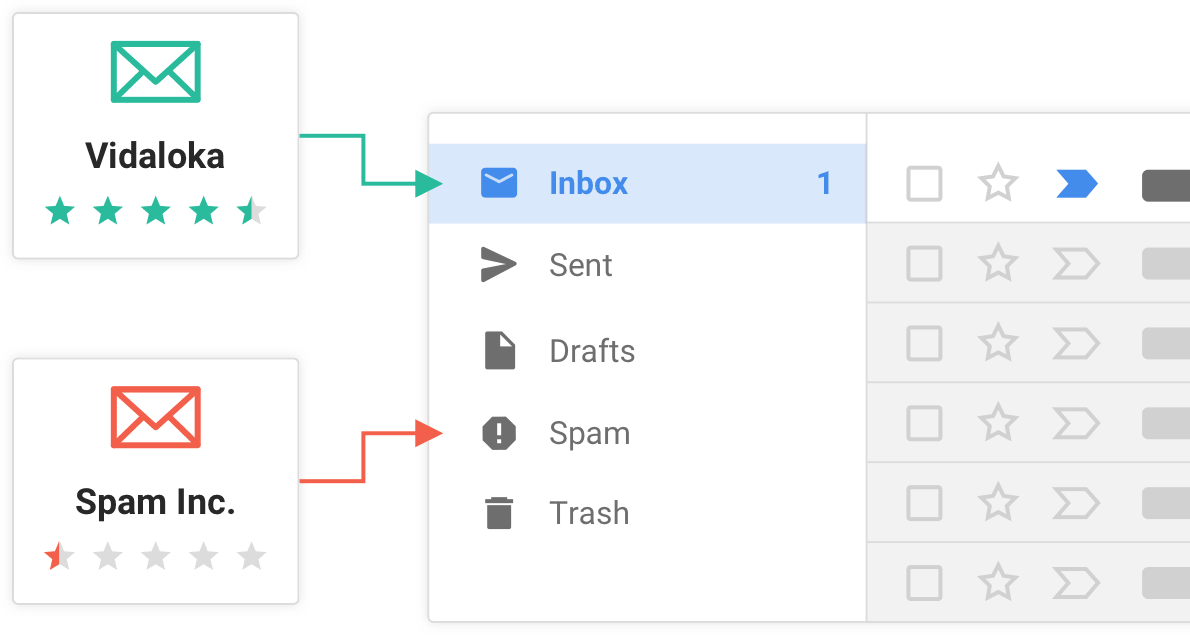Deliverability
Spam traps: What are they and how to avoid them
Spam traps can trip up many legitimate businesses if they’re not careful. Learn what spam traps are, how they work and how to avoid them in this post.

PUBLISHED ON
When it comes to online mail, spam traps can be the bane of many companies’ existence. Spam traps and your spam folder certainly aren’t all bad. They can help filter out the phishing scams, junk deals, and fake Nigerian princes to ensure that you’re getting the mail--and by extension, the information--you truly need.
Unfortunately, the same spam traps that help you filter your inbox are the same ones that can trip up many legitimate businesses if they’re not careful. With good guidelines and execution, however, these businesses can rest assured that their emails will land in their customers’ inboxes.
In this article, we’ll tell you more about spam traps and how to avoid them. Are you ready? Let’s go!
Table of content
Pristine spam traps
Recycled domain spam traps
Recycled address spam traps
Invalid email traps
What you shouldn't do
What you should do instead
What is a spam trap?
You can’t hate spam traps entirely--they’re designed to help us.
Spam traps are fraud management tools that monitor email communications to identify spammers and senders with incorrect contact management practices. Spam traps look like legitimate email addresses, but they aren’t used for two-way communication or operated by real users. These email addresses can easily be placed on mailing lists to catch and flag spam and harmful communications.
Spam traps often take the form of honeypots. Honeypots are email accounts specifically and solely used to attract and detect spam emails and other unhelpful or malicious communications, as well as their original sender’s email address. When a phisher or spammer attempts to send bad emails to a honeypot account, an automated system can take note of the spam sender’s details and make a record of the trap.

Types of spam traps
There are different types of spam traps you should be aware of. Some of the most common ones include:
Pristine spam traps
Pristine traps, or honeypots, are brand-new email addresses that are created by internet service providers and other groups, such as blacklist organizations, who are interested in tracking spam.
Since these addresses have never been used, they have no history or reputation associated with them, and are good for generating fresh spam reports. Businesses could hit pristine spam traps by using unverified third party email lists and using bots to scrape email addresses from the web.
Recycled domain spam traps
A domain that is no longer used by a business or individual (for example, recycleddomaintraps.net) may be purchased by a spam trap owner and secretly reactivated to collect mail. The owner can then see who is sending email to any addresses of that domain even after the domain is supposedly no longer live.
Recycled address spam traps
These are similar to the above recycled domain spam traps. If someone signs up to receive a newsletter, the newsletter isn’t spam. However, if that subscriber doesn’t log into their email account for two or three years after subscribing, the email provider may decide to shut down the account for a period of time due to inactivity.
If this account is reopened by the provider to track which emails are being sent to it, and the newsletter is still being received, this tells the provider that the newsletter sender never checked to see which of its emails were actually “wanted” (i.e. opened or engaged with). Thus, the newsletter will likely begin to be marked as spam.
This is why it is important to regularly update your mailing list and get rid of unresponsive addresses and domains.
Invalid email traps
These traps are email addresses that differ slightly from real email addresses due to typos. For example, an email address like regularguy@gmail.com could become regularguy@gnail.com or regularguy@gmaii.com in a typo spam trap.
Because these traps are generally set off by simple sender typos, the consequences for getting caught in one are usually either very light or nonexistent--as long as you don’t keep spamming the same “wrong” addresses.
How can spam traps be bad for business?
If you’re part of a legitimate business hoping to have an engaged, active emailing list, you should always be aware of potential spam traps, and of being caught by one (or more).
Remember those consequences we mentioned earlier? Well, if you’re flagged by a spam trap, some of the consequences you could be facing include:
A ban on your IP address: We all have IP addresses that are used to help identify our devices and their internet networks. A ban on your IP address means that you would be unable to send communications from that IP’s device, which could interfere with your business.
A ban on your sending domain: You can spend hours thinking about the perfect name for your online company. However, if your sending domain is banned, all that time will be wasted. It will take time and be hard to repair your domain’s reputation, and you’ll need the best deliverability experts to help you get back on track.
Decreased revenue: If you’re flagged as a spammer, future emails sent from your account will probably land in your recipients’ spam folders or be rejected entirely. Emails from a spam folder are far less likely to be read than emails in a primary inbox, so these future emails will be read and engaged with less frequently--and ultimately lead to decreased revenue for your business.
As email capabilities and usage become increasingly widespread, it’s easy to see how your email deliverability becomes increasingly important. If you don’t stay ahead of your email lists, your emails may end up blocked or undelivered. This decreases the impact and potential return on investment of your email strategy.
However, if you follow recommended guidelines and are mindful of your deliverability, your email strategy can become a great investment as an engagement tool for your business.
Want to know more about deliverability best practices? Download our guide now!
How can you avoid spam traps?
It may feel difficult to ensure that you’re staying on the right side of the email deliverability scale. Luckily, there are many ways you can avoid spam traps and their spooky dark side. There are some general best practice do’s and don’ts to follow to keep your email communications running smoothly.
What you shouldn't do
Here are some dangerous practices you should not do if you want to avoid spam traps:
Allow inactive or unengaged email addresses to linger on your mailing list. Older, unused email addresses are commonly used for spam traps, and unengaged customers may complain that your communications are spam. A shorter list of real subscribers is better than a longer list that hasn’t been cleaned in a long time. .
Buy email lists from anyone. You may want to expand your mailing list quickly, but many for-sale addresses aren’t legitimate and often belong to honeypots or spammers themselves. Instead, grow your list organically.
What you should do instead
These are the best practices you should follow to protect yourself against spam traps:
Apply double opt-in policies when signing up new subscribers to your mailing list. When someone signs up, have them type in their email address and then verify it in a separate box. This helps ensure that the subscriber types their email address correctly and doesn’t stick you with a non-existent or bad address.
Validate your email lists and clean them regularly --ideally, every three to six months. Make sure that your list is clean and includes engaged subscribers who have interacted with your emails at some point after your last email validation.
Segment your database so you’re only sending emails to active contacts. Use a sunset policy on your email list to ensure you’re filtering out anyone that hasn’t engaged with your emails in a reasonable amount of time. If you send emails on a weekly basis, that might be anyone that hasn’t opened a message in the last three to six months. If you email your contacts daily, you’ll want to filter out anyone that hasn’t opened one in the last month.
Managing your email deliverability and keeping your list safe requires consistency. Understanding the risks is hard, but following best practices and having the right email partner will help you prevent mistakes that could damage your email reputation. Always make sure you’re an email Jedi, not an email Sith.
How can Mailjet help?
We’re glad you asked! Email marketing and deliverability is kind of our thing, and we have all sorts of tools that can help you maximize your mailing list and retain high-quality, loyal subscribers.
With Mailjet, you can easily create and embed a double opt-in subscription widget to capture email addresses in the safest way. With double opt-in, your contacts will have to confirm their email addresses before they make it into your contact list.
You’ll also be able to use our segmentation feature to apply a sunset policy on your mailing list. Just segment your active subscribers and filter out anyone that hasn’t engaged with your messages in the last few months.
High volume senders can also benefit from additional services to monitor their email deliverability, including email verifications, and dedicated deliverability expertise to maintain a healthy reputation and maximize their chances of landing in the inbox. Interested? Talk to an expert now!
Spam traps are fraud management tools all senders should worry about. However, following these best practices will help you ensure that your subscribers are legitimate and your business runs smoothly.
Have any questions about spam traps or deliverability in general? Reach out to us on Twitter or check out the Mailjet blog for even more tips on how to maximize your email deliverability and impact. Did someone say Jedi Master?
Related readings
Popular posts

Top email marketing trends for 2022
To the outsiders, it can sometimes feel like email hasn't changed that much since it was created. Maybe this is why some are so persistent in...
Read more

Reducing email’s carbon footprint
When it comes to protecting our planet, every step toward cleaner practices – small and big – counts. So, what if we told you that emailing, as clean and green as it seems...
Read more

Marketing calendar 2024: Dates you shouldn’t miss this year
We finally got through 2023 (phew!) and Q1 is just around the corner. It’s time for you to start scribbling down your New Year’s Resolutions to make sure we start the year with a bang. If you’ve found your way here, we’re guessing that’s because creating a winning...
Read more



